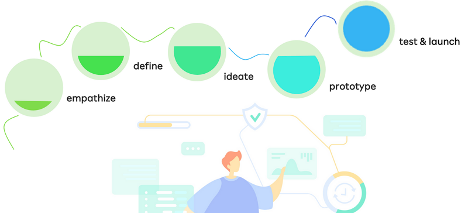By: Ganeshkumar KR
In the age of speed, instant gratification, automation, productivity, and delightful experiences, you've likely encountered a term that is being aired more frequently than ever before: Design Thinking. Once mostly discussed and leveraged in the realms of user experience and product management, its adoption is finally function-agnostic—the utopian dream of its conceptualizers. Simply put, it's a mindset, a framework, an approach toward solving problems via human-centric, innovative solutions that are iterative and non-linear in nature.

Easier said than done, it's not a silver bullet, especially in the world of tech and internet/cloud-based enterprise products that range from assisting airline companies in monitoring billions of flight bookings to managing national databases that hold sensitive and personal information of billions of citizens. The enterprise user persona differs significantly from a non-enterprise user persona, and hence, the design thinking approach towards enterprise products has its unique guidelines. What are they? Read on!
Prioritizing and timing user-experience(Delight beyond the UI)
Unlike B2C apps where you’d aim to impress users with their initial appearance, enterprise apps need to prioritize functionality and robustness. I once worked on software that assisted content creators from the world’s top fashion brands in creating single and multi-page visual catalogs. Their existing solution often crashed and was unstable, resulting in numerous reworks and delays in sending catalogs to agencies and events, thereby compromising their competitive edge. We developed a dozen out-of-the-box templates tailored to the fashion domain, rigorously tested them with high-resolution images, and ensured flawless processing on the first attempt, regardless of the circumstances. This involved designing both the front end and the back end. While the UX was initially rudimentary, user trust was quickly established as their visual catalogs were delivered on time in every instance. Subsequently, we released three UX updates per month, which not only enhanced user satisfaction but also reduced their stress levels by 2.5 times through improved typography, color palette, and transitions.
Driven by self-serviceability
There was a time when companies devised elaborate training and onboarding plans for users to familiarize themselves with enterprise software. However, times have changed dramatically. It's crucial to recognize that enterprise users are also B2C consumers who interact with numerous apps both at work and in their personal lives. Whether it's fast performance or a delightful user experience, one thing they value most is the ability to learn to use apps independently. I once worked on building an analytics platform for a life sciences company, where I had to create a compelling landing page for executives worldwide to make daily decisions. Through user interviews, I gathered the key data points each user wanted to access. During this process, I discovered that some users appreciated Android's feature that allows customization of app widgets on their home screen, and they expected something similar from all the software they used. As a solution, we provided an option to toggle between standard widgets and a configuration tailored to each user's needs. This combination of configurability and self-serviceability resulted in the highest Net Promoter Score (NPS) we had received in a long time.
Creating the mezzanines
Most B2C apps have frequent updates, and most users love it when done right. There is also an expectation to keep improving with updates. One of the reasons could also be at times there are experimental and half-baked features that are tried in A-B tests. Enterprise apps can’t afford too many frequent changes unless they are not impacting the user-experience. Given the fact that it does thru UATs and other audits, things are rather tighter. That is not to say you cannot experiment. I term an approach as creating mezzanines (a mid-floor between two floors). Here are some:
- A-B test with the power users only to begin with as many decisions are top-down. They love it, trust it, they advocate it. These needn’t be only for B2C apps, move beyond representative users.
- Break a massive change into logical chunks in the flow (across releases) — too many changes in the flow might derail the users.
- Fire up a playground tenant that goes live on Friday and the users expect something refreshing they can provide inputs about. This will lead to data driven decisions as against other methods that aren’t fail safe.
- Never hesitate to gamify! Create leaderboards for playground tenant and incentives. Creating an engagement will activate lead to genuine feedback and forgiveness towards issues.
I had tried each of the above for a product of mine, and majority of the users reported to use our platform first every day and there was 1.8x rise in productivity, their bosses reported!
Cognizant about the hierarchy of users
Unlike the B2C realm, where user experience considers various cohorts of users but maintains a uniform user experience for all, enterprise software operates differently. It is structured based on hierarchies driven by different roles and responsibilities, each with versatile and varied expectations. Therefore, your user experience strategy must also have layers, but the goal is to achieve the optimal and minimal number of changes necessary. For instance, a membership platform I worked on once had a significant user base from the Middle East, while the management was centralized in Europe. The European users required various integrations with third-party platforms, whereas the Middle Eastern users did not. From colour schemes and language preferences to access levels, security measures, and seamless transitions between integrations, understanding the needs of both user groups, as well as the nuances of third-party systems we didn't own, was crucial for the platform's success. It took several iterations to strike the right balance of changes, and patience for continuous observation was key.
Summing up
This isn’t an exhaustive list, but it's a good start. As you may have noticed, the above covers all the popular phases of design thinking. When done right for enterprise apps, it can yield stellar results and eventually lead to growth in top-line metrics. And let's not forget about AI! GenAI should be integrated into the design thinking process to analyze, extrapolate, and explore the myriad of options we can generate, drawing insights hidden from our eyes, among other benefits. The bottom line: moderation is key. Experimentation is crucial to finding the sweet spots, and it should be done with regular cadence, as that sweet spot is a moving target! In addition to delighting users with a great and immersive user experience, enterprise apps must leverage design thinking to make users feel empowered – that feeling of flying on the wings of eagles. May the force of design thinking be with you!





